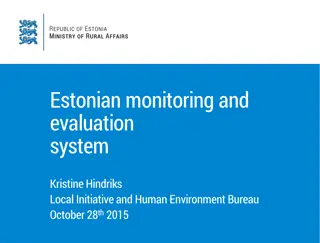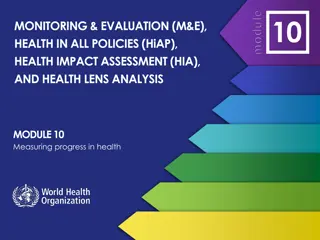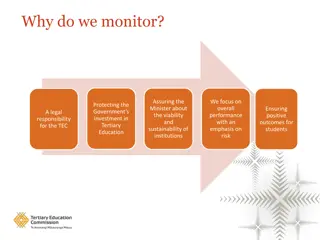Understanding Monitoring, Evaluation, and Learning in Health Programs
This content provides insights into the fundamentals of Monitoring, Evaluation, and Learning (MEL) in health programs. It covers terminology, the role of MEL plans, the purpose of MEL, information decision-makers need, and the definition of a MEL plan. By reviewing these concepts, professionals can enhance their understanding of measuring program effectiveness.
Download Presentation

Please find below an Image/Link to download the presentation.
The content on the website is provided AS IS for your information and personal use only. It may not be sold, licensed, or shared on other websites without obtaining consent from the author. Download presentation by click this link. If you encounter any issues during the download, it is possible that the publisher has removed the file from their server.
E N D
Presentation Transcript
M&E of Health Programs Monitoring, Evaluation, and Learning (MEL) Fundamentals M&E Orientation July 31, 2018 Dhaka, Bangladesh
Learning Objectives Review terminology and concepts related to MEL Understand and discuss the role of MEL Plans in program planning and improvement
Monitoring, Evaluation . . . Monitoring Routine tracking and reporting of priority information about a project or program: its inputs, activities, outputs, and outcomes. Evaluation Systematic collection of information about the activities, characteristics and outcomes of a specific program to determine its merit or worth. Source: Basic Terminology and Frameworks For Monitoring and Evaluation. UNAIDS 2010
. . . and Learning Learning Use of data and insights from a variety of information-gathering approaches including monitoring and evaluation to inform strategy and decision making
Purpose of Monitoring, Evaluation, and Learning The purpose of monitoring, evaluation, and learning is to measure program effectiveness.
What information do decision makers need M&E data to provide? Process: Was the program carried out as planned? How well was it carried out? Results: Did the expected change occur? How much change occurred? Impact: Is the change attributable to the program? Does the change mean program success ?
MEL Plan: Definition Document describing all MEL activities in a program Program objectives, interventions developed to achieve them, and procedures to be implemented to determine whether or not objectives are met Expected results of the program and how they relate to goals and objectives Data needed and how they will be collected and analyzed Information use, including resources needed to do so How the program will be accountable to stakeholders
MEL Plan: Function Guides implementation of program MEL o Enhances coordination, standardization State how program will measure achievements o Accountability Documents stakeholder consensus o Transparency and responsibility Helps achieve program results o Ensure good use of data Preserves institutional memory o A living document, adjusted for program modification
MEL Plan: Components 1. Introduction 2. Program description 3. M&E framework 4. Indicators 5. Data sources, collection, and reporting systems 6. Plans for data use and dissemination 7. Capacity needs for implementation 8. Analysis of constraints & potential solutions 9. Plans for demonstrating program impact 10. Mechanism for plan updates
3. What are we doing? Types of Monitoring Process monitoring Tracks the implementation of program activities (inputs, activities) Quality assessment Examines the content and approach used in the program Assesses quality and consistency Process evaluation Focuses on changes in the program needed for corrective action during program implementation
4. Are we implementing the program as planned? Types of Monitoring o Output monitoring Tracks the number of activities (trainings, resources and services) implemented over the course of the program and whether they are happening at a level sufficient to cover the target population as intended Quantitative in nature o Outcome monitoring Periodic assessment of the effects from program inputs and outputs, usually initiated after the first or second year of the program and annually thereafter For national health programs, outcome monitoring is typically conducted through population-based surveys.
5. Are interventions working/making a difference? Outcome evaluation Understand the kind of change desired and the means by which that change could occur Operationalize the definition of the desired change Identify appropriate indicators that can measure the change Determine the feasibility of the program to produce the desired change
This presentation was produced with the support of the United States Agency for International Development (USAID) under the terms of MEASURE Evaluation cooperative agreement AID-OAA-L-14-00004. MEASURE Evaluation is implemented by the Carolina Population Center, University of North Carolina at Chapel Hill in partnership with ICF International; John Snow, Inc.; Management Sciences for Health; Palladium; and Tulane University. Views expressed are not necessarily those of USAID or the United States government. www.measureevaluation.org

























